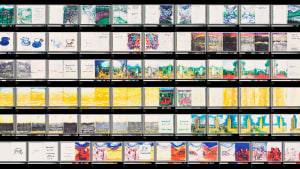Processing the Page: Computer Vision and Otto Piene’s Sketchbooks
Tuesday, Jul 05, 2022 10:00a -
Sunday, Jul 31, 2022 5:00p
Where:
Harvard Art Museums
32 Quincy Street
Cambridge, MA 02138
Admission:
$20 Adults $18 Seniors (65+) Free Sundays—free to all! Free All students with a valid ID Free Harvard ID holders (plus one guest) Free Harvard Art Museums Friends Free Youth under 18 Free Cambridge residents (proof of residency required)
Categories:
Accessible Spots, Art, Date Idea, Good for Groups, Photoworthy, Rainy Day Ideas, Tech, University
Event website:
https://bit.ly/3IevNIn
The Busch-Reisinger Museum was recently gifted more than 70 sketchbooks kept by artist Otto Piene (1928–2014). Dating from 1935 to 2014, the largely unpublished sketchbooks reflect interdisciplinary, cross-media experiments from Piene’s long career in the Boston area and abroad, including both realized and unrealized projects. A pioneer in multimedia and technology-based art, Piene was long interested in optical perception and kinetic forces, resulting in a body of work that emphasizes collaboration and the intersections of art, science, and nature. The diverse themes and approaches in Piene’s sketchbooks open pathways into his individual artistic practice as well as into the multivalent nature of the sketchbook: an art object, a portable studio, a record of visual thinking, and a space for material experimentation. “[M]any ideas have sprung up in full flight during the physical act of making things,” Piene once remarked. “To a large extent, art comes out of the practice of art.”
While researching, cataloging, and digitizing the sketchbooks—over 9,000 pages—Jeff Steward, the museums’ director of digital infrastructure and emerging technology, and Lauren Hanson, the Stefan Engelhorn Curatorial Fellow in the Busch-Reisinger Museum, teamed up to show how curatorial practice coupled with computer science and data visualization can expose hidden stories, spawn new conversations, and transform our understanding of Piene’s artistic practice. This installation brings to light their experimentation with human and AI-generated data. Through large-scale monitors on the gallery wall, visitors can browse Piene’s digitized sketchbooks by using either an iPad stationed in the gallery or their own smartphone. The sketchbooks are presented as a large matrix of thumbnail images arranged in chronological order; each page is viewable in high resolution. The pages can also be explored by dominant color or by AI-generated descriptive tags.
In the spirit of Piene’s dedication to collaborative practice and learning through creating, we invite visitors to interact with this installation and explore the vibrant imagery and information within the sketchbooks, while also experimenting with emerging technologies and digital tools as a means for creating new information, new knowledge, and new ways of seeing.
-

Sponsored -

SponsoredBoston Women's Market at Night Shift Brewing
Saturday, Mar 15, 2025 12:00p
Night Shift Brewing (Everett Taproom)
-

Sponsored -

SponsoredSt Patrick's Day Weekend: The Great American Beer Hall
Saturday, Mar 15, 2025 12:00p
The Great American Beer Hall
-

SponsoredFrom Tree to Treat! Join our Guided Maple Syrup Making Tour at a Local Farm
Saturday, Mar 15, 2025 9:00a
Natick Community Organic Farm


